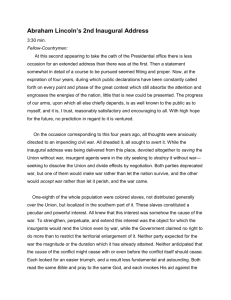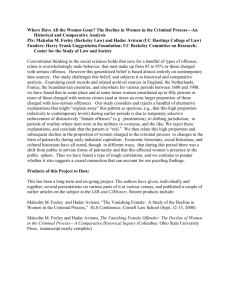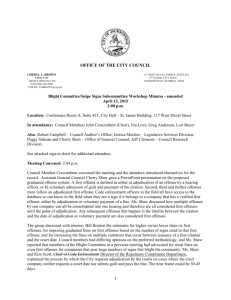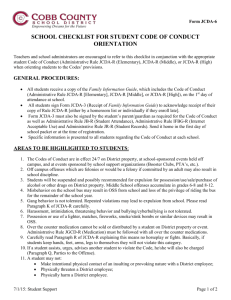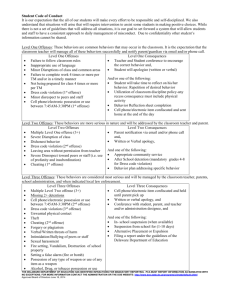A New Approach to (an Old) Offense Classification JFS
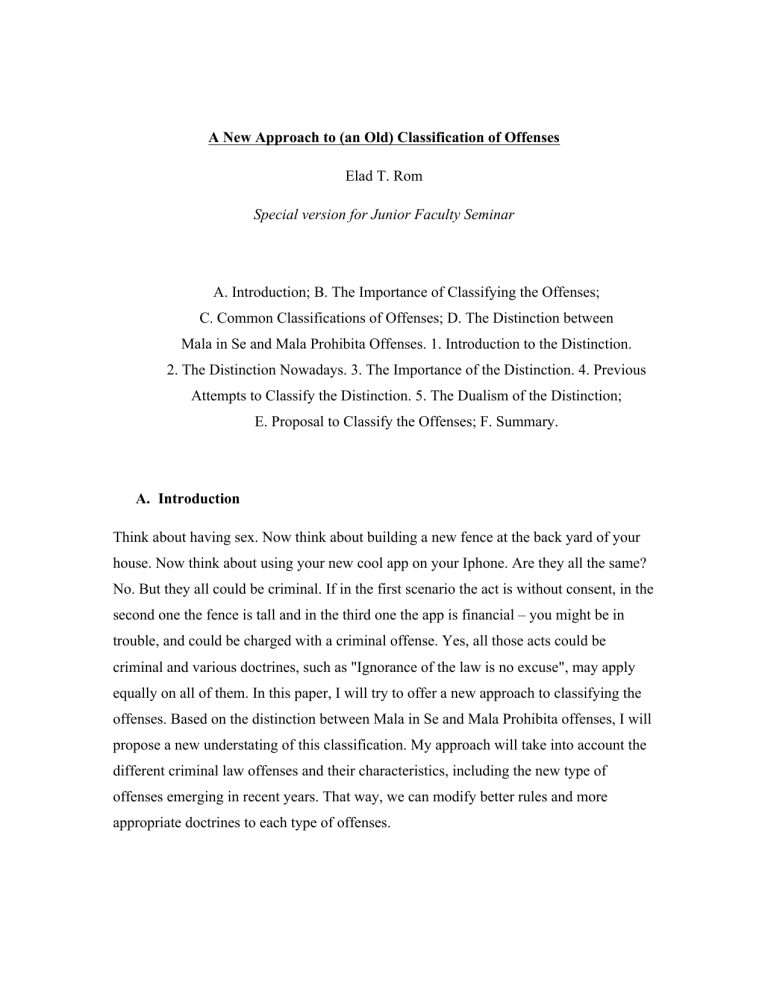
A New Approach to (an Old) Classification of Offenses
Elad T. Rom
Special version for Junior Faculty Seminar
A. Introduction; B. The Importance of Classifying the Offenses;
C. Common Classifications of Offenses; D. The Distinction between
Mala in Se and Mala Prohibita Offenses. 1. Introduction to the Distinction.
2. The Distinction Nowadays. 3. The Importance of the Distinction. 4. Previous
Attempts to Classify the Distinction. 5. The Dualism of the Distinction;
E. Proposal to Classify the Offenses; F. Summary.
A.
Introduction
Think about having sex. Now think about building a new fence at the back yard of your house. Now think about using your new cool app on your Iphone. Are they all the same?
No. But they all could be criminal. If in the first scenario the act is without consent, in the second one the fence is tall and in the third one the app is financial – you might be in trouble, and could be charged with a criminal offense. Yes, all those acts could be criminal and various doctrines, such as "Ignorance of the law is no excuse", may apply equally on all of them. In this paper, I will try to offer a new approach to classifying the offenses. Based on the distinction between Mala in Se and Mala Prohibita offenses, I will propose a new understating of this classification. My approach will take into account the different criminal law offenses and their characteristics, including the new type of offenses emerging in recent years. That way, we can modify better rules and more appropriate doctrines to each type of offenses.
It is important to understand that the modern criminal law is no longer the same traditional criminal law. Throughout the years, it has changed and evolved, and became more complex with a proliferation of different crimes. Contemporarily, it seems absurd to generalize all those different offenses as one “criminal law”, and apply the same rules and doctrines as if all the different types of offenses are the same.
It is true that (broadly) until the 20 th century, most – if not all – of the offenses were of the same type – hardcore criminal law prohibitions that deal with hardcore vicious acts.
[Husak/ Green] The definitions for those crimes vary from “Mala in Se” offenses to common law offenses or capital crimes. Even though there are different titles, the meaning is clear – traditional criminal law crimes. It is wrong, it has been wrong for a long time, and we have no doubt that it is wrong. A normative member of our society should not do those acts. If he does, in the eyes of most of society, he should be locked up in jail. Those are the Mala in Se offenses – bad in itself, independent of and prior of the law (hereinafter: Mala in Se). The top 3 examples for those crimes are clear: murder, rape and theft.
However, as time went by and the state has recognized the power of criminal law to enforce various governmental goals, the use of criminal law has rapidly increased.
Meaning, more and more criminal law offenses have been enacted and more acts are now criminal. Within these then-newly enacted offenses, are those offenses that were not considered wrong before the enactment of those laws. A normative member of our society might have done those acts before, and no one would think he is a bad person, or
“a criminal”. Those offenses are commonly known as “Mala Prohibita” offenses – bad because they were prohibited (hereinafter: Mala Prohibita). The candidate for most cited example for this type of offenses is driving on a certain side of the road.
Usually, the classification stops here. There are the hardcore crimes that are clearly wrong (ala Mala in Se) and those that are wrong only because they were prohibited (ala
Mala Prohibita). This analysis seems to me a bit superficial, and in my view this classification needs to be refreshed and reconsidered. There were indeed those hardcore crimes, which were wrong even before being prohibited and it possible to assume that everyone knows them. Afterwards, however, a new type of criminal law offenses was
starting to emerge, as there was a criminalization of new acts that were not considered crimes or even wrongs – but now a member of society would know they are crimes and, as I’ll further explain later, also know they are wrong.
It should be noted, that the timeline is not necessarily in chronological order but rather as a general trend. We should bear in mind that there is a limited amount of acts that are wrongfully independent of and prior of the law. There are exceptions, of course, and new
Mala in Se acts could be prohibited but it is not nearly as common as the possibility of a new Mala Prohibita act being prohibited. This could be clearly seen by the expansion of the criminal law with Mala Prohibita crimes.
Now, it seems to me that the classification should go further – there is a “Third
Generation” offenses, which not only a member of society would not assume they are wrong, but also has no reason to think there are prohibited. Those crimes are protecting interests far less traditional and in a much more indirect means than Mala Prohibita crimes, much so that they constituting a whole new type of offense. Some sort of "Mere
Prohibita" offenses. A great field of examples for those crimes is the field of financial crimes.
In this paper, I will try to show that the ever-changing criminal law has reinforced a need for a reexamination of the classification of offenses. It is no longer the basic criminal law based on the values, beliefs and mainly – morals of the society. This classic criminal law
(represented by Mala in Se offenses) is now only a limited part of the whole modern criminal law. The modern criminal law is much more complicated than it used to be, and the different types of offenses should be recognized and separated. There is not only
Mala in Se and Mala Prohibita offense. There is a new type of criminal law offenses, which have significantly different characteristics than the other known criminal law offenses. The paper will attempt to offer a new approach to classifying the offenses, based on the Mala in Se – Mala Prohibita distinction.
B.
The Importance of Classifying the Offenses
As previously stated, the criminal law is composed by a large number of different offenses. These offenses deal with different matters, protect different interests, apply to different people and mainly differ from one another in a various different ways or characteristics.
The importance of classifying the criminal law offenses has long been recognized by different scholars. There is an understating that a specific law could be referred in general terms and that the different crimes could be connected by substantive principles. The importance of the classification is that it could be a window to the moral and social content of certain offenses [Green]. I find the classification important due to the fact that it allows us to modify better rules and more appropriate doctrines to each type of offenses.
In recent years, however, major doubts were raised regarding the validity and scope of the classic classifications and there is a serious need of rethinking the classification theory. This paper tries to offer a reexamination of the classification of offenses based on the traditional distinction between Mala in Se and Mala Prohibita offenses, as will be further analyzed below.
C.
Common Classifications of Offenses
The task of classifying the criminal law offenses is not new to the criminal law theory or to the practice. Various classifications have been proposed and some of them were even been used in practice (see e.g., the MPC classifications). Those classifications, however, are either too superficial or not comprehensive enough. They do not provide the necessary framework to distinguish between the different types of offenses in the modern criminal law today.
The common classifications are: (1) felonies and misdemeanors; (2) Mala in Se crimes and Mala Prohibita crimes; (3) crimes involving moral turpitude and crimes that do not;
(4) major crimes and petty crimes; (5) common law crimes and statutory crimes; (6) inchoate crimes and consummate crimes; and (7) infamous crimes and non-infamous crimes. [Lafave/ Husak]
The different classifications can be classified to two types: classifications regarding the nature of the crime, and classifications regarding the punishment.
Classifications regarding the punishment are: (1) felonies and misdemeanors; (2) major crimes and petty crimes; and (3) infamous crimes and non-infamous crimes.
Classifications regarding the nature of the crime are: (1) Mala in Se crimes and Mala
Prohibita crimes; (2) crimes involving moral turpitude and crimes that do not; (3) common law crimes and statutory crimes; and (4) inchoate crimes and consummate crimes.
The classifications I focus on are those regarding the nature of the crime, mainly because in my view those are the classifications that can provide the framework for discussion and implantation of the rules based on the fundamental nature of the crime. The classifications regarding the punishment are important but only as analytic tool that usually helps us to understand the moral implications. We should remember that the punishment is a divertive of the nature of the act, and not the other way around. It is important to understand the different types of offenses and the distinctions between them, in order to apply the appropriate doctrines and rules. Only after understating the different nature of the crimes, we can draw the punishment based on those conclusions.
When it comes to the nature of the crimes, all of the classifications are roughly divided into two: hardcore wrongs and additional wrongs, as can be illustrated:
Hardcore wrongs
Mala in Se
Moral turpitude
Common law
Consummate
Additional wrongs
Mala Prohibita
No moral turpitude
Statutory
Inchoate
To generalize, hardcore wrongs crimes are those that are well established in the society as wrongs. Those are the initial crimes of criminal law, dating at least as far as its constitute in the common law era. Those are the crimes that were wrong even before they were prohibited, based on the mores of the society. There is a general moral consensus that those acts are bad, and should not be committed. Every “good character ” layman of society could have his conscience as a guide to its wrongfulness. In those crimes the underlying protected interest is classic/ hardcore – life, body or property, and the means for protecting it are classic/ hardcore as well – the act that is being done directly. This is the case with crimes such as murder, rape and theft.
Additional wrongs crimes are those that were integrated or included in the criminal law only later, after there was an established common sense of what criminal law is and what are the prohibited offenses. Those are the additional crimes, enacted roughly in a later time than the initial crimes. Upon enactment, they were not considered as bad but merely wrong because they were prohibited. They had no moral attachment to them, and therefore the moral conscience was not helpful. Even though the underlying protect interest is a classic/hardcore one, the means for protecting are indirect and relatively more advanced. An example for those crimes could be driving without a valid license.
The distinction between different crimes (and the relevant wrongs) aligns directly with the classic distinction between Mala in Se crimes (wrong by itself, prior/ independently of the law) and Mala Prohibita crimes (wrong because they were prohibited).
The following section both discusses the distinction and re-examines the classification of said criminal law offenses.
D.
The Distinction between Mala in Se and Mala Prohibita Offenses
1.
Introduction to the Distinction
The distinction between Mala in Se offenses and Mala Prohibita offenses is the main classification in criminal law that survived through time, and is the origin of the other nature of the crime classifications.
The Mala in Se classification in the Anglo-American law has been dated at least as far as the 15 th century. The first discussion in the distinction was held in the English case law dealing with the king’s powers. The doctrine was used to claim that the king’s power of release and pardon do not apply to Mala in Se offenses. It was ruled that those offenses are inherently bad and therefore so evil that they deny the possibility of a royal pardon.
In theory, the perception was that Mala in Se offenses are originated from a higher source than the king. Given that the king is god’s representative on earth, the logical source of the Mala in Se crimes is god himself. [Wolfe]
Although throughout the years, the king’s powers were abolished, the distinction between
Mala in Se offenses and Mala Prohibita offenses has stayed the same and remained unclear.
This distinction was imported from the British law to the American law upon its inception in end of the 18 th century. The initial distinction was between common law crimes and statutory crimes. The notion was that Mala Prohibita offenses were created by using the positive law, and the question was whether the source of the criminality was legislative or not. [Wolfe]
This distinction, however, has its flaws. Firstly, it was argued that there are many laws that there were perceived morally wrong long before their positive enactment. Wolfe's reply is that we should distinguish between statues that merely “declared” the criminal nature of a certain act and between statutes that “created” a new criminal source.
Secondly, it was argued that as time went by, more statutory crimes have replaced the common law crimes and therefore this method of distinguishing the offenses has become less efficient. [Gray] Even so, it can be clearly seen that the distinction still exists and is vital and renowned as ever.
2.
The Distinction Nowadays
The distinction between Mala in Se crimes and Mala Prohibita crimes is a source of ongoing controversy and disputes, both by scholars and the courts. The main problem with the distinction is the difficulty to classify some crimes in one group or the other. The distinction is often criticized for not providing a clear method to distinguish between the two types of offenses. [Sillimack]
The distinction is criticized for being imprecise, unreliable and fundamentally unclear .
The courts in the US are often confused between the different classifications and disagree about them.
The courts have tried to articulate guiding lines and sub-tests in order to decide how to classify the different crimes. The common derivative classifications are: [And we can see the similarities with the hardcore wrongs crimes and the additional wrongs crimes classification above]
Mala in Se
Danger to life or limb
Criminal intent is an element
Common law
Moral turpitude
Mala Prohibita
Other crimes
Criminal intent is not an element
Statutory
No moral turpitude
.
These classifications, however, are only general guidelines and are not rigid criteria. In fact, there were cases, for example, where statuary crimes have been held to be Mala in
Se, etc.
According to Davis, it seems that the US Supreme Court decisions from the early 20 th century distinguish between Mala in Se and Mala Prohibita offenses on the basis of the ends they promote. Mala in Se offenses serve moral ends whereas Mala Prohibita offenses serve social ends.
Kahan holds that when the courts decide whether an offense is Mala in Se or Mala
Prohibita they necessarily take into account moral considerations.
The consensus is that there are no precise rules to distinguish between the offenses and that it would be impossible to make an organized list classifying all the offenses. [Wolfe/
Lafave]
Another possible way to classify crimes is by the degree of the violation. Meaning, for example, that speeding slightly over the limit may be classified as Mala Prohibita, but speeding at extreme speed will be Mala in Se. [Lafave] It seems to me that a “slight” violation is an act that an average person might do. While severe violation indicates that is it morally wrong that an average person would not have done.
3.
The Importance of the Distinction
The traditional classification between Mala in Se and Mala Prohibita offenses, although an ancient one, is still a live and vital one. In practice, courts still use the classification and cite the offenses as Mala in Se or Mala Prohibita. The US Supreme Court has even acknowledged the distinction as “Well Recognized”. The same goes for Criminal Law textbooks, which usually discuss the distinction. The distinction also can be found in various criminal researches and scholars’ works. Many view the distinction as a useful tool that simplifies and arranges the discussion. [Luna]
The distinction also has important implications nowadays. For example, it is being used in the felony murder doctrine, where if the original offense is classified as Mala in Se, the actor could be convicted with murder if it occurred following or during the commitment of the original offense. Whereas if the original offense is classified as Mala Prohibita, then the liability of the actor could be reduced and might even be limited only to the original offense. [Of course, this is only a general phrasing of the doctrine. The scope of the liability may vary from jurisdiction to jurisdiction]
I will argue elsewhere that the model for recognizing a mistake of criminal law defense should also be based roughly on that classification. There are scholars that argue that mistake of criminal law defense should apply when the offense which the actor was mistaken about was a Mala Prohibita one (e.g. Travis). However, they leave the classification task to the courts or the legislature. In this paper, I attempt to offer the framework to classify the offenses so it could be later used to design an appropriate model for recognizing a mistake law defense.
4.
Previous Attempts to Classify the Distinction
As discussed, the distinction between Mala in Se and Mala Prohibita offenses seems clear on the surface. However, the distinction is much more complicated in reality and hard to define in practice. Courts have struggled with it, so did the various scholars that have tried to distinguish the different types. Some offered their own method of classification, while other just gave up and completely abandoned the distinction. We shall now review the previous attempts that were made to distinguish between the Mala in Se and the Mala
Prohibita offenses.
According to Boyce & Perkins, Mala in Se is an act that is intolerantly below the decent moral behavior standard, whereas Mala Prohibita act is not morally culpable (e.g., parking over time).
In a later paper, Perkins distinguished between Mala in Se and Mala Prohibita offenses as follows. According to him, Mala in Se offenses punish guilty acts, whereas Mala
Prohibita offenses merely enforce the rules that were enacted due to non-moral related reasons. The key to distinguish the two is inquiring whether the punishment is based on a moral wrong or not.
According to Duff, Mala in Se offenses call for retributive punishment, whereas Mala
Prohibita offenses do not.
Davis describes Mala Prohibita offenses as those that "do not stir the same strong community sentiments evoked by violent and other more serious crimes". According to him, If Mala in Se and Mala Prohibita were the only term, every offense that is not Mala in Se should be classified as Mala Prohibita. [While analyzing Gabor's writing, Davis specifically commented: "He notes that failing to resister firearm is not a Mala in Se. By implication, he obviously considers it a Mala Prohibita"] In this paper, I disagree with this approach and offer to create a middle classification.
Davis distinguishes between Mala in Se offenses and Mala Prohibita offenses based on equity. According to his equity view, "Mala in Se is an act that violates the norm of reciprocity, most likely through serious form of exploitation or retaliation for which reparation or restoration is not possible". For example, in a rape of a virgin, the virgin has suffered a loss that cannot be recovered. The emphasis is on irreparable harm, and it is not limited solely to life, limb and property. For example, in the crime of embezzlement, the broken trust may not be recoverable. For the irreparable harm to qualify as a Mala in
Se, the actor must have a criminal intent. That way, accidental killing, for example, is not classified as Mala in Se. However, the intent does not necessarily have to be attached to the specific act that results in irreparable harm, but rather a general intention to engage in wrongdoing will suffice. Davis stretches the general intent to engage in wrongdoing also to intent to commit a Mala Prohibita act. To sum up, Davis defines Mala in Se as "an intentional act that results in irrecoverable harm".
According to Luna, Mala in Se offenses involve acts or threats of violence, theft or fraud
– meaning, offenses protecting individuals and property. On the other hand, he defines
Mala Prohibita offenses as offenses that lack the element of direct harm to specific people but still are prohibited because their negative consequences influence the society as whole.
Robinson, however, holds that aside from the offenses protecting individuals and property, we can also agree on newer forms of acts as Mala in Se, such as offenses protecting the community.
According to Swigert, society objects to the public nature of the acts prohibited by Mala
Prohibita offenses. The status of those acts is not the same as the acts underlying Mala in
Se offenses but still, by prohibiting them the society expresses its disapproval of committing those acts in public. It seems to me that this approach is anarchic (as was expressed in 1984). It is no longer the case with financial crimes, which are supposedly handful of the Mala Prohibita offenses.
Research conducted by Teevan showed that those who committed a certain act are more likely to define it as Mala Prohibita.
To continue this line of thought, it seems to me that offenses which are committed by an average person of society, or are likely to be committed be an average member of society, should be classified as Mala Prohibita. That way, the classification matches the social consensus regarding those acts. Acts that society does not view as wrong (and an average member is likely to commit them) surely should not be classified as Mala in Se – They are not part of the moral consensus of the society as wrongs.
Kahan argues that the only way to distinguish between Mala in Se and Mala Prohibita offenses is by examining the act in light of normative morals values external to the positive law. Hence, in the context of Ignorance of the law, for example, if one wishes to know what the law is, he has to view the world from a "good person" perspective.
In conclusion, it seems that most of the scholars indentify a certain moral content in Mala in Se offenses, while indicating its absence when it comes to Mala Prohibita offenses. We can also conclude that the common way to analysis the possible classification is whether it is a Mala in Se offense or Mala Prohibita offense. I find it a bit superficial and not attentive enough to the different characteristics of the types of offenses, as will be demonstrated in the next chapter. Also, apart from Robinson, the scholars do not even consider the possibility that the classification of a certain offense may change over time. I hold that what used to be a Mala Prohibita offense might become a Mala in Se offense, and vice versa.
5.
The Dualism of the Distinction
Social moral perceptions may change over time, and from generation to generation. We should bear in mind that there are interactions between morality and criminal law. The social moral perception is influenced by what is illegal. [Bell & Friedman] Therefore, a revision of the classification of certain crimes should be considered over time, especially regarding a morally-based classification.
It is plausible that there are crimes that used to be classified as Mala Prohibita offense but now should be classified as a Mala in Se offense. Those are the crimes that were considered as Mala Prohibita because they were not wrongs before they were prohibited by statue. The only reason they were wrong was due to the fact that a law prohibited them, and they had nothing to do with one’s moral conscience as they were not part of the moral consensus. I think, however, that the classification of some of those crimes should be revised. It is true that once, upon enactment, they were not considered as part of the moral consensus, but now – ten or hundred years later – they are part of this consensus, and an average man of society would and should know they are wrong.
Back in the early common law days, the sense of what is morally wrong was drawn from the Bible and from the preacher (or rabbi, etc.) that instructed the believers what is wrong. Those biblical wrongs were transformed into the social mores that ultimately became the Mala in Se crimes.
The same logic applies at present time. The sense of what is wrong is drawn from the law and the statues. The government instructs us what is wrong. After a while, those wrongs are embedded in society and become part of the social mores. Those well-established
Mala Prohibita offenses are now part of the moral consensus of what is wrong, and therefore should be classified as Mala in Se offenses.
Those crimes are well-embedded in criminal law and an average person in society already knows – or at least suspects – that they might be illegal. It became part of society's consensus that it is illegal. In accordance with the notion that knowingly breaking the law is immoral, it is part of the moral consensus of the society.
This rationale applies for driving on the wrong side of the road, for example. Although it was wrong only because it was prohibited by a statue, now it is well-known and noncompliance with that law is immoral. This used-to-be Mala Prohibita offense is so well-established that everyone knows that if you commit it you are risking life. The means of protecting the underlying protected interest are now so clear that they are more direct that indirect and therefore those offenses should be classified as Mala in Se.
It could also be the other way around. There are laws that used to be part of the moral consensus and are not anymore. The classic example is same-sex intercourse.
A great example for an offense that used to be classified as Mala in Se and should be classified as Mala Prohibita nowadays is selling alcohol. In the US of the early 20 th century selling alcohol was considered wrong. A large group of people believed that whoever sells alcohol is vicious and immoral, and should be punished. They persuaded the majority of the society in their belief and it became a part of the public conscience.
The purpose of enacting the liquor laws was to punish the people who do those wrong acts and not to regulate the field. [Perkins] Contemporarily, it is clear that the common perception does not view selling alcohol as wrong itself (as long as it is sold to adults), but rather as a legitimate act that simply should be regulated. The perception has changed and therefore these offenses should be classified now as Mala Prohibita.
The moral consensus which is relevant is the moral consensus nowadays [Encarnacion].
An old moral legislation which has nothing to do with the current moral consensus should not be considered as Mala in Se, but rather as Mala Prohibita. This crime is wrong nowadays only because it is prohibited.
E.
Proposal for Classifying the Offenses
As discussed earlier, there were many changes and developments to the criminal law throughout the years. Nowadays, we can identify several types of criminal law offenses that differ significantly from one another. Those differences have a great importance when it comes to the criminal liability, such as in cases where there was a mistake of criminal law. By identifying the different types of offenses, we can modify better rules and more appropriate doctrines to each type of offenses.
Each offense has two main components: its Protected Interest ( X ) and the Means of
Protecting it ( Y ).
For our needs, we can identify two types of protected interests: Classic ( C ) and
Modern ( M ).
The classic protected interests (C) are those interests based on the community’s basic morals values. The common interests are life, limb, property and etc.
The modern protected interests (M) are newer and usually deal with new subjects not of interest to the criminal law in the past or being thought as none of the state's business to deal with them, or even if it is – the criminal law was not the way to do so. These interests tend to be more abstract, such as administrative ones.
We can also identify two types of means of protecting the interest: Direct ( D ) and
Indirect ( I ).
Direct means of protection ( D ) are those in which the offense clearly identifies the harm.
Indirect means of protection ( I ) are those in which the offense does not clearly identify the harm.
Hence, theoretically, there are four different types of offenses, as can be illustrated by the table below:
Means Interest Classic (C)
Direct (D) CD (1)
Modern (M)
MD (3)
Indirect (I) CI (2) MI (4)
1.
Classic protected interest and direct means of protecting it offense (CD)
These are the basic and more severe offenses, such as murder, rape and theft. The protected interest is classic and the means of protecting it are direct – it is clear that the murder offense is protecting life, and the theft offense is protecting property.
2.
Classic protected interest and indirect means of protecting it offense (CI)
Many of the offenses in this category were usually the source of controversy regarding their classification as Mala in Se or Mala Prohibita. As discussed earlier, a good example is driving on the wrong side of the road. The offense is protecting life but by indirect means. There are also clearer examples such as building or modifying a house without a license.
3.
Modern protected interest and direct means of protecting it offense (MD)
4.
Modern protected interest and indirect means of protecting it offense (MI)
These two modern interest offenses are the usually of regulatory or administrative character. Most of society does not necessarily know of their existence and even if they do – they would have a hard time understanding them. There is no common sense that they are even "wrong because they are prohibited" (ala Mala prohibita), and they constitute their own class of "Mere Prohibita". Many of those are financial offenses, such as a failure to report a stock-related transaction conducted in a foreign bank.
I propose to link the classification of the offenses above to the immediacy of the wrongfulness of the offense.
As a general guideline, we can classify the offenses based on the immediacy of their wrongfulness. The immediacy of their wrongfulness is based on the type of the protected interest and the means of protecting it. The more the protected interest is more of the
"classic" type and the means of protecting it are more direct, the wrongfulness of the offense is more immediate. The immediacy represents the way the protected interest and the means of protecting it are perceived while committing the offense, in a manner in which the actor has a reason to believe his action is illegal, or at least doubt its legality.
Type CD of the offenses represents the most immediate wrongfulness, where type MI represents the least immediate wrongfulness. Type CD's wrongfulness is so immediate that by committing the act, the actor should have his conscience as a guide to know it's wrong and probably illegal. As the immediacy of the wrongfulness is reduced, there are more steps that are needed to be taken in order to know or even doubt whether the act is illegal. I will further elaborate on this matter elsewhere.
F.
Summary
In this paper, I tried to offer a new approach to classifying the offenses. Relying on the distinction between Mala in Se and Mala Prohibita offenses, I proposed a new understating of this distinction, based on the immediacy of the wrongfulness of the offenses. The framework for the classification is identifying the protected interest and the means of protecting it. My approach enables to take into account the different criminal law offenses and their characteristics, including the new types of offenses. By using my proposed classification, we can modify better rules and more appropriate doctrines to each type of offenses.
